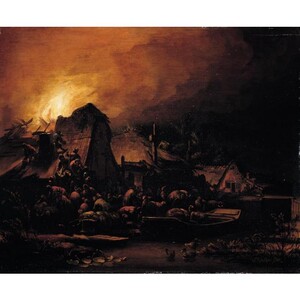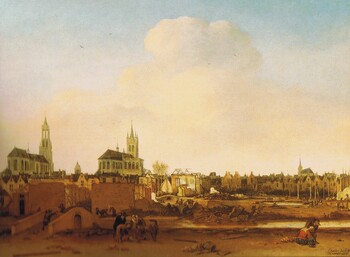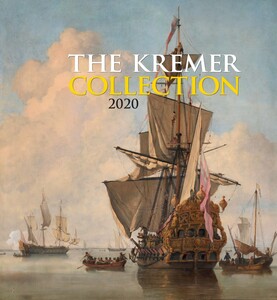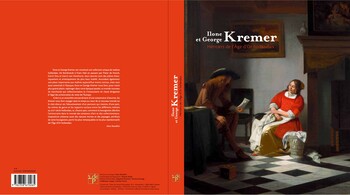8.000 €
Egbert van der Poel
Village fire at night
Oil on panel : 26,78X 35,31cm
Signed and dated bottom right “Evanderpoel 1658”
Frame : 38,5 X 46,8 cm
Provenance : - bought by The Kremer Collection at AAG Glerum, Amsterdam, 15/04/08 for 10.251 €
- The Kremer Collection until November 2025
Published :
- “Ilone et George Kremer. Héritiers de l’Âge d’Or hollandais, Nr. 24
(catalogue of the exhibition held at the Pinacothèque de Paris,
27/10/11 – 25/03/12)
- “The Kremer Collection 2020”, P. 260
In short
Egbert van der Poel was the most important 17th century Dutch painter of nocturnal fire scenes, so-called “Brandjes”. He must have developped this particular speciality in the latter part of his career. In Rotterdam he influenced several painters who also turned to this subject.
Until November 2025 our painting sat in the highly important Kremer Collection.
About Egbert van der Poel
Dutch painter
Delft 1621 - 1664 Rotterdam
Painter of so-called “Brandjes” (scenes of nocturnal fire) and of “Maneschijntjes” (scenes of moonshine).
Occasionally he also painted genre scenes set in barn interiors and beach scenes.
Pupil of the versatile painter Cornelis Saftleven (1607 – 1681) in Rotterdam. Saftleven had been active in Antwerp between 1632 and 1634, and then in Utrecht, before returning to Rotterdam in 1637, where he had grown up with his parents and two brothers.
Son of the silversmith Lieven Ariensz. van der Poel from Delft.
Elder brother of the lesser known painter Adriaen Lievensz. van der Poel (Delft 1626 – in or after 1671 Leiden).
Our painter remained in Rotterdam after his training until circa 1650, when he moved back to his nearby native town of Delft. In 1650 he joined the local Painter’s Guild, in 1651 he married in Maassluis Aeltgen Willems van Linschooten; the couple had four children.
On Monday morning, the 12th of October 1654, an important part of the city of Delft was destroyed, due to the accidental explosion of one of its gunpowder magazines. Many hundreds of inhabitants are said to have been killed by this “Delft Thunderclap” (“Delftsche Donderslag”), among them the famous painter Carel Fabritius and most probably one of Egbert’s own daughters (as she was buried two days after the disaster). Egbert soon moved back to Rotterdam, either in that same year of 1654, or at the start of the next year. His three daughters had been born in Delft, his son in Rotterdam. Egbert remained here until his death in 1664.
About “Brandjes”: nocturnal fire scenes
Fire has always been a fascinating subject for painters.
Biblical and mythological themes, such as the Destruction of Sodom and Gomorrah, or the Fall of Troy, formed excellent pretexts for painting fire.
During the 17th century artists started painting common, daily subjects.
In 1623 Esaias van de Velde painted a battle scene at night round a burning building, in 1637 Rotterdam-based Willem Viruly II painted a nocturnal fire scene with plundering soldiers.
Egbert van der Poel painted some twenty views of the Delft powder house explosion: either of the tragic event itself or of this devastated area of the town afterwards. It is generally thought that following the success of these scenes he started painting blazing fires at night in small towns and villages, with numerous figures and details.
Egbert van der Poel is considered the best specialist in this domain of nocturnal fire scenes. He influenced his brother Adriaen, Adam Colonia (1634 – 1685) and Philip van Leeuwen (who died in 1723). “Brandjes” were a popular subject in Rotterdam.
Why should you buy this painting?
Because it is a fully signed and dated small jewel by the 17th century Dutch specialist of nocturnal fires, with a great provenance.
Entry of our painting in “The Kremer Collection 2020", P. 160/161
Egbert van der Poel specialised in a highly specific sub-genre of landscape painting: city and village fires at night. Any blazing fire provided a dazzling spectacle, but the contrast between the blackness of the night and a luminous sea of flames gave scenes of this kind an added fascination. Time is needed to accustom one’s eyes to the darkness of the painting, after which numerous previously invisible details appear to come into view. And so it is in this painting, dating from 1658. The viewer’s eye is initially drawn to the flames shooting from the thatched roof of a farmhouse. The blaze is scattering countless burning embers ¬¬– small dots of red and yellow, finishing touches that Van der Poel added with the tip of his brush. The fire does not appear to be spreading very fast: part of the roof is still intact, and those inside are able to save themselves and some of their possessions, with the help of bystanders. Property is being piled high on a horse-drawn cart. But the hectic atmosphere generated by a fire is also palpable, especially in the man seen on the left, on the path: the despair is clearly visible in his features.
Van der Poel was born in Delft, but he is mainly associated with Rotterdam, where he is believed to have had his training. In 1650, the artist enrolled in the St Luke’s Guild in Delft, but after the devastating explosion of a gunpowder store on 12 October 1654, in which he lost a child, he decided to leave the city for good and to settle in Rotterdam.1 Van der Poel’s interest in disasters, as reflected in his village fires, is also clear from the many paintings he made of the gunpowder explosion in his native city. There was evidently a lively market for scenes of this kind, a seventeenth-century variant of today’s ‘disaster tourism’. But it was above all his brandjes (fires), as they were called, that made him famous. He was even celebrated in his own day as Holland’s best ‘fire painter’!2 The technique of depicting fire was discussed as a separate theme in painting manuals, with the correct use of colour and the careful observation of real fires featuring as the main points of emphasis.3
Van der Poel was not the only artist who practised this sub-genre. Aert van der Neer (1603/04-1677), who specialised in nocturnal scenes, also produced brandjes, which were compositionally very different from the highly distinctive work of Van der Poel. While Van der Neer frequently placed the seat of the fire on the horizon, as part of the landscape, Van der Poel brought the fire to the foreground, making it the primary theme. Zooming in on the fire in this way also enabled Van der Poel to devote more attention to the details that make his scenes so lively: people escaping or extinguishing fires, a variety of animals, typically Dutch pollard willows, and usually a small lake or river in the foreground. Like Van der Neer, Van der Poel also painted nocturnal scenes without fire, in which the focus was on the marvellous play of moonlight on the landscape – paintings of this kind were aptly called maneschijntjes – moonshines.4
It seems that the majority of nocturnal fires were painted in Rotterdam. Most of Van der Poel’s brandjes were made after his move to Rotterdam, and other artists who were active in the genre also came from this city. Two of Van der Poel’s followers (both from Rotterdam), Adam Colonia (cat. no. 13) and Philip van Leeuwen (?-1723), painted nocturnal pieces that greatly resemble his work, in style as well as subject matter. While Colonia was trained by his father, Isaack Colonia (1611/12-1663), Van Leeuwen may well have been apprenticed to Van der Poel. Their work is sometimes so similar as to be almost indistinguishable.5
Although Van der Poel also painted historical disasters, such as the gunpowder explosion in Delft, most of his disasters sprang from his imagination. An exception to this rule is his 1662 painting of the great fire that raged in the village of De Rijp in the night of 6 January 1654. This well-nigh inextinguishable fire ravaged more than 800 buildings, making it a calamity on the same scale as the explosion in Delft that same year.6 But Van der Poel focused chiefly on fictional fires like the one shown here; he painted large numbers of them. This high productivity lent a rather uneven quality to his brandjes. But Fire in a village at night is one of his more carefully elaborated paintings, which, thanks to its fine state of preservation, still gives a convincing representation of the ‘Light and Fire in the Night’.
Comparative paintings
Click photos for more details






